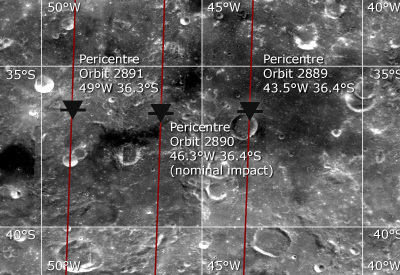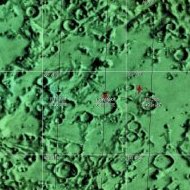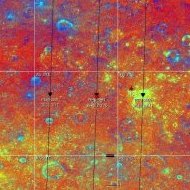SMART-1: Call for Ground Based Observations
16 August 2006
For latest impact calculation click hereLike most of its lunar predecessors, SMART-1 will conclude its scientific mission to the Moon through a controlled impact on the lunar surface. This is scheduled to take place on 3 September 2006 at 05:41 UT in the Lacus Excellentiae region.Due to uncertainties in the detailed knowledge of the lunar topography, it is possible that SMART-1 will impact on the previous orbit at around 00:36 UT.
The table and graphic below show the impact coordinates and orbital trace for the nominal impact orbit [2890] and the two orbits on either side [2889 & 2891]. Ground based observing requirements favour an impact on either the nominal orbit, or nominal-1 and a further orbital adjustment could still be made to ensure this scenario occurs.
| Nominal -1 | 3 September 2006 |
00:36 UT |
43.5° W | 36.4° S |
| Nominal | 3 September 2006 |
05:41 UT |
46.3° W | 36.4° S |
| Nominal +1 | 3 September 2006 |
10:46 UT |
49.0° W |
36.3° S |
Impact Science
Lacus Excellentiae is very interesting from the scientific point of view - it is a volcanic plain area surrounded by highlands, but also characterised by ground mineral heterogeneities.
"We call for ground-based observations mostly to study impact physics, the release of spacecraft volatiles, and the lofted soil mineralogy, plus exospheric and environment effects," says Bernard Foing , SMART-1 Project Scientist at ESA. "We look for fast imaging of the impact and of the associated ejected material, and for spectroscopic analysis, for example to find hints about the mineralogy of the impact area."
Even if the impact at 2 kms-1 is of modest energy, the plume might be observable if it reaches sunlight, with an amateur telescope or binoculars. For sites not covering the time of impact, we ask for context observations before and after impact to look for the ejecta blanket.
An overview of possible observations and the driving science goals are given in the overview page 'Impact Science'.
Observing Campaign
A number of observatories have already confirmed their participation to the observing campaign:
- VLBI Very Long Baseline Interferometry and radio observatories
- South African Large Telescope SALT
- Calar Alto
- ESA OGS Optical Ground Station at Tenerife
- CEA Cariri in Brazil
- Argentina National Telescope
- Florida Tech Robotic telescopes
- Hawaii NASA IRTF
- Hawaii Subaru auxiliary 30cm telescope
- ODIN observatory (from space)
ESA calls on other observatories to join the campaign and requests interested professional astronomers to contact Dr. Bernard Foing.
In addition ESA calls on amateurs around the world to participate in making observations of the Moon. Unfortunately the Moon is not visible from Europe when the impact occurs - but observers are encouraged to observe the impact region before and after the event for evidence of ejecta material ploughed up during impact.
A free software package to visualise the Moon or targeted regions on the lunar surface at a given date and at different magnifications, is available for computers running Windows. See the related link to "Virtual Moon Atlas". Note: the VMA 'Light' version 3.0 is sufficient.
Contact
B.H. Foing
SMART-1 Project scientist
Bernard.Foing esa.int
esa.int



